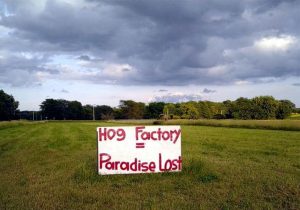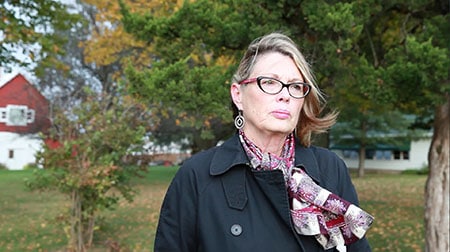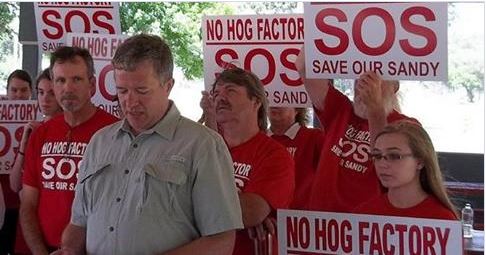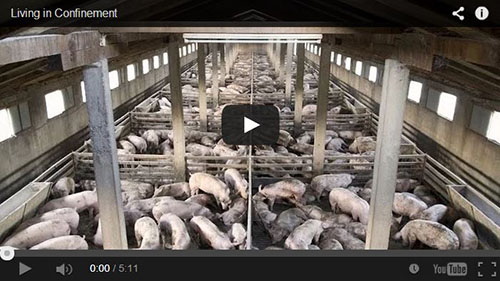David Leifheit once lived on “a little slice of heaven” in Ogle County, about halfway between the churning metropolis of Chicago and the muddy waters of the Mississippi River, Illinois’ western border. He proudly maintained the home he built himself on his mother’s ancestral land – land homesteaded by his great-great-grandparents over 150 years ago. The house sat at the edge of an old and rich forest, overlooking a prairie which boasted two ponds and a sparkling stream running through it. From his porch, David kept vigil over more than 1,000 family monuments—trees his father had planted when young, now reaching high up into the pristine skies of rural Illinois. When David speaks of his former home, his voice takes on the unmistakable timbre of a man in love. And in mourning.
David still lives on this property, but it is no longer the same place. In 2006 trouble found its way into heaven. That summer, David received notice that a neighbor would be building a 4,800-head hog confinement a quarter of a mile from his home. David’s life has not been the same since.
 In rural Illinois it is easy to find stories similar to David’s. Stories of people who lived to be outdoors now retreating inside, shut off from the world of fresh air and open spaces that once defined and drove them. Stories of a farming paradise swept under by an unrelenting tide of factory farm stench and pollution. Stories of lives lived in confinement.
In rural Illinois it is easy to find stories similar to David’s. Stories of people who lived to be outdoors now retreating inside, shut off from the world of fresh air and open spaces that once defined and drove them. Stories of a farming paradise swept under by an unrelenting tide of factory farm stench and pollution. Stories of lives lived in confinement.
Like David, Nancy Spratt treasured her summers outdoors on her family farm, with children splashing in the pool and ducks swimming in the pond. But also like David, Nancy’s world has been remade by the presence of a nearby hog confinement and the shifting winds that now determine whether she can open her windows or even walk outside without retching.
How is such a horrible smell created? How many hogs have to die to create this?
“It’s been horrible in recent weeks. If it’s not at our house, it’s in town. It’s an everyday smell now. Twenty-four years ago, I could walk outside, breathe my fresh country air. And I think I have a right to do that. Since the hog facility came, we can’t open up our house. Should we have to live like that? We shouldn’t.”
Nancy is quick to point out that she is under no illusion of what it is to live on and around farms. “We are farmers,” declares Nancy. “We have cattle, chickens and ducks. We take pride in our farm. We love our livestock, but I’m not an animal rights person. We raise cattle and we raise them to be butchered.”
Nancy is emphatic that these factory farms are, in fact, heavy industry, and nothing like farms at all.
“How is such a horrible smell created? How many hogs have to die to create this? It makes me question whether they are running it properly, and it makes me wonder what the long-term health effects are of breathing this in everyday.”
“And you have to wonder about the runoff. Salt Creek runs right behind us. What is it doing to the soil? What are they pumping into the soil?”
Sometimes the stench will even invade Nancy’s home.
“I wish the owners had to smell that. I would like to bottle that for them. But you can’t bottle and replay a smell, a smell that’s in your home, in your house. I just don’t understand how they can get away with this.”
They had never denied a single factory farm in the state.
Factory farms get away with it because Illinois’ laws are inadequate for preventing and addressing the multiple, critical threats posed by these facilities. And factory farms have faced few hurdles in establishing their dominance over the Illinois livestock industry.
David Leifheit began experiencing similar horrors immediately after the nearby hog confinement was built. Some days it was so bad it would burn his eyes and lungs, forcing him inside, walled off from the joy his farm once gave him.
In response, thirteen neighbors sued the owners of the factory farm, a husband and wife team, who then set about systematically eliminating plaintiffs via legal maneuvering and threats. The wife was the county clerk and neighbors were fearful of reprisals from a politically and economically powerful couple.
After six years of stalled litigation more than half of the plaintiffs had given up. Feeling the cards were stacked against them at every level, and after expending significant money and time, the suit was dropped.
At an Illinois Department of Agriculture (IDOA) hearing for a proposed dairy in a different part of the state, David asked the IDOA representative how many factory farms the Department had denied.
“He told me zero. They had never denied a single factory farm in the state. They are just there to help the CAFO corporations build.”
Nancy’s brother-in-law is a judge and organized hundreds of thousands of dollars to fight a hog factory farm in Western Illinois. He was easily defeated. When the factory farm near Nancy was proposed, a neighbor looked into what recourse the community might have. According to Nancy, he determined, “It’s useless. Nothing can be done.”
It is a tragedy that the state would turn its back on rural residents and throw away what makes life in the country so special. That is not lost on Prairie Rivers Network and we have been working for some time to strengthen the laws that govern factory farms. So, while neighbors currently have little recourse, we are fighting to change that, to protect the people living near factory farms, and to protect Illinois’ streams and rivers. We have proposed a bill that would do just that, limiting the harms caused by factory farms and giving more control to local communities.
This bill would go a long way to prevent what happened to David and Nancy from happening to people like Mark Durham, who, along with the community group “Save Our Sandy,” has been fighting to prevent a new mega hog farm from locating in Marshall County along Sandy Creek. Mark describes Sandy Creek as a bass angler’s paradise – rocky in parts, sandy in others, well-shaded and cool because of the dense, native timber it flows through.
“I hate the thought of this thing getting destroyed. I have a 6 year old grandchild that loves to fish. I’m teaching him to fly fish this year. I want him to be able to do the same thing with his children.”
As do we.
You can meet David and Nancy in our short documentary “Living in Confinement” we produced about factory farms in Illinois.
Help protect the people living next to factory farms!












